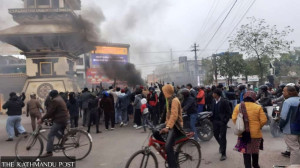National
Government has yet to get oxygen-related supplies to treat Covid-19 patients
As the second wave of Covid-19 pandemic grips the country, the government has so far wholly relied on donors and private sector for crucial medical equipment.
Prithvi Man Shrestha
The government relied on oxygen-related materials donated by other countries, organisations and individuals and those supplied from the private sector during the second wave of Covid-19 pandemic while itself failing to procure even a single item.
All the while, the country’s health facilities were overwhelmed with the coronavirus patients, a lot of whom died because they could not get the critical care requiring oxygen or a ventilator.
It was only in late April that the government invited domestic oxygen manufacturers for a meeting after seeing people dying in large numbers in neighbouring India due to oxygen shortage.
And soon enough the health facilities in Nepal were hit by a shortage of oxygen and oxygen cylinders.
By the time the government issued a bid notice on May 10 to procure oxygen supplies and accessories, it was already late. The country was amid the second wave of infection, fuelled by more virulent variants of the virus, and the authorities had enforced prohibitory orders and travel restrictions to slow down the spread.
Understandably, the government’s bid invite did not get any response.
“The potential vendors may not have taken interest in supplying oxygen cylinders due to difficulty in supplying the goods because of the lockdown,” Dr Bhim Sing Tinkari, director at the Management Division under the Department of Health Services, told the Post.
Some suppliers of medical goods say besides the lockdown, a tight delivery schedule stipulated by the government also made them hesitant to bid for the contract.
According to the bid document, half (500 pieces) of the oxygen cylinders and concentrators each were supposed to be supplied within 15 days of signing of the contract while the rest were to be delivered within 30 days.
“With the lockdown and international flights suspended, suppliers saw the difficulty in delivering the consignment within the deadline,” said Suresh Ghimire, president of the Chemical and Medical Suppliers’ Association Nepal.
In order to deliver the goods within the deadline, the suppliers also needed to charter a plane, a process which too could take time.
The government’s plan to install oxygen plants has also not progressed.
“We have signed an agreement with an international organisation for installing oxygen plants in all seven provinces with the assistance of the World Bank,” said Tinkari.
Progress has also been slow on the front of procuring ventilators. The Ministry of Health and Population had ordered the Department of Health Services to immediately procure 50 ventilators in late April. The department issued a tender notice for ventilator procurement only on May 20. The deadline for bid submission expired on May 27.
As per the bid document, the supplier is required to supply 25 ventilators within 10 days of signing of the contract while remaining 25 ventilators should be supplied within 20 days.
Government officials admit to the failure in procuring the oxygen-related goods in time.
“We have not procured anything related to oxygen for the last six months,” Tinkari said.
Ghimire, the president of Chemical and Medical Suppliers’ Association Nepal, said the government failed to prepare for the second wave of pandemic.
Despite continued warnings from health experts, the government did little to shore up the country’s healthcare system.
Ever since President Bidya Devi Bhandari dissolved the House of Representative on December 20 last year at the recommendation of Prime Minister KP Sharma Oli, the country has lurched from one political crisis to another. Meanwhile, the crisis caused by the pandemic has been altogether ignored.
“Had the government procured the necessary medical goods last year, the people would not have suffered as they are right now,” said Baburam Marasini, former director at the Epidemiology and Disease Control Division under the Health Ministry. “Health experts and international experiences showed that a second wave of the pandemic was imminent. Even if the second wave had not hit Nepal, the country should have been prepared for such a situation.”
With the government failing to procure the oxygen-related materials, it relied on donations and charities.
China, the United States, Switzerland, Finland, Spain, the United Kingdom, Thailand, France, Japan and the United Arab Emirates supplied various medical goods, including oxygen cylinders, oxygen concentrators, liquid oxygen cylinders, ventilators and antigen kits.
The United Nations Children Fund, various international non-governmental organisations and the private sector also donated various medical equipment.
According to the data unveiled by the Social Welfare Council, as many as 119 domestic and international NGOs delivered 3,258 oxygen cylinders, 813 oxygen concentrators, eight oxygen plants, and 101,440 relief materials as of June 4 to tackle the second wave of pandemic.
Likewise, they also supplied 2,443 isolation and hospital beds with oxygen facility, 113,543 PCR test kits, antigen test kits and reagents and over 5.6 million face masks, isolation kits, oximeters and personal protective equipment.
The number of coronavirus cases has been decreasing since late May. On Monday, the country reported 3,370 new cases and 92 died in the last 24 hours, according to the Ministry of Health and Population.
“Due to the decreasing cases, the available oxygen-related materials are more or less enough for now. But we have to prepare ourselves for a potential third wave,” said Tinkari.




 14.99°C Kathmandu
14.99°C Kathmandu
.jpg&w=200&height=120)






%20(1).jpg&w=300&height=200)







